- Fitness App Market Size
- What Is A MyFitnessPal App?
- How Fitness Apps Like MyFitnessPal Work?
- How Businesses In The Fitness Industry Can Benefit By Building A Mobile App?
- Fitness and Nutrition App Types
- Must-Have Features To Develop An App Like MyFitnssPal
- Cost Affecting Factors To Consider To Develop An App Like MyFitnessPal
- How To Develop A Fitness And Nutrition App Like MyFitnessPal?
- Top 5 Apps Like MyFitnessPal In The Market Right Now
- Tech Stack To Consider To Develop An App Like My FitnessPal
- Conclusion
- FAQ
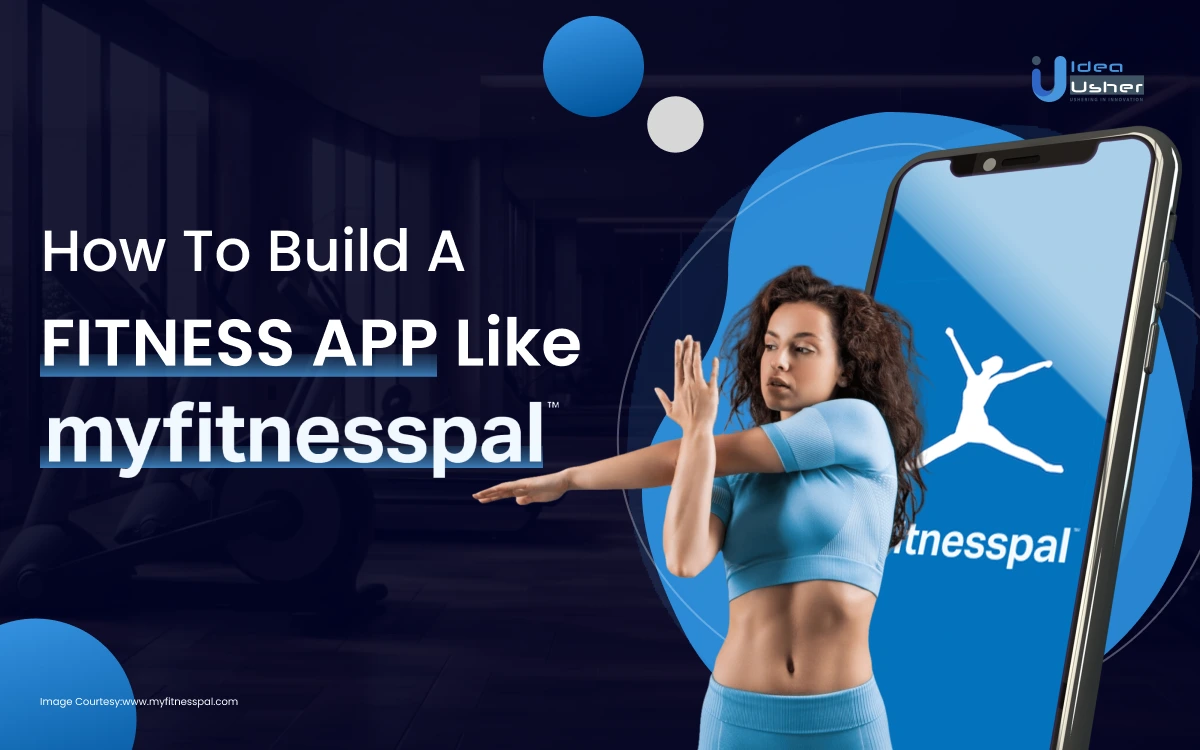
A growing number of people are willing to take action to improve their health since they are increasingly concerned about them. Furthermore, the rate of advancement of technology has an intrinsic relationship to it.
The epidemic has increased demand for fitness and nutrition app development. People want to use fitness monitoring apps and expert advice to help them achieve their goal of being healthy at home. The industry is seeing an enormous increase in fitness and nutrition applications.
You should be familiar with comparative apps like MyFitnessPal and have a list of their features on hand if you want to enter in the fitness app market.
This article has all the information you need if you’re thinking about creating a fitness application. Let’s take a closer look at how to create a fitness and nutrition app with crucial app development aspects such as business opportunities, essential features, development steps, tech stack, and others.
- Fitness App Market Size
- What Is A MyFitnessPal App?
- How Fitness Apps Like MyFitnessPal Work?
- How Businesses In The Fitness Industry Can Benefit By Building A Mobile App?
- Fitness and Nutrition App Types
- Must-Have Features To Develop An App Like MyFitnssPal
- Cost Affecting Factors To Consider To Develop An App Like MyFitnessPal
- How To Develop A Fitness And Nutrition App Like MyFitnessPal?
- Top 5 Apps Like MyFitnessPal In The Market Right Now
- Tech Stack To Consider To Develop An App Like My FitnessPal
- Conclusion
- FAQ
Fitness App Market Size
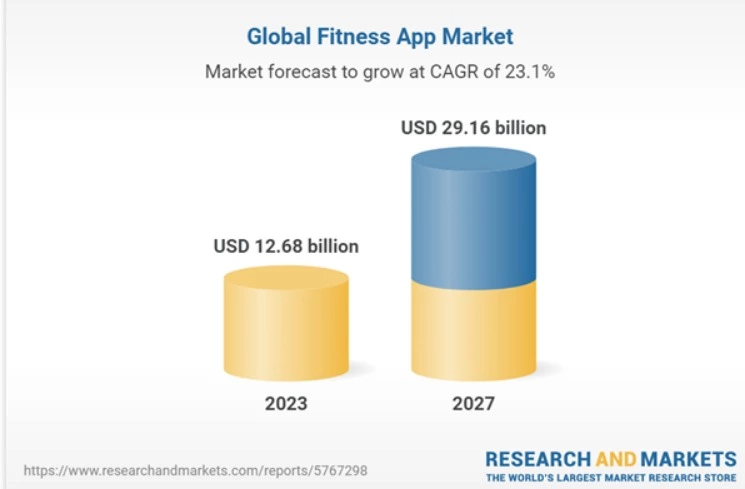
Image Source: ResearchandMarkets.Com
For businesses, the growing fitness app sector offers a lucrative business opportunity. Convenient and personalized exercise solutions are in high demand as more people focus a higher priority on their health and wellness.
Fitness applications are now more accessible than ever thanks to the widespread use of smartphones and wearable technology. Businesses that enter the fitness app space may benefit from this expanding industry by providing cutting-edge features, customized experiences, and comprehensive health solutions.
What Is A MyFitnessPal App?
MyFitnessPal is a popular mobile application and web-based platform designed to assist individuals in managing their fitness and nutrition goals. Under Armour developed MyFitnessPal as a comprehensive tool for tracking daily food intake, exercise routines, and overall physical activity.
The app lets users log and monitor their meals, record exercise sessions and set personalized fitness goals. It features a vast database of foods, including nutritional information, which allows users to input and track their caloric and nutrient intake easily. Additionally, MyFitnessPal provides insights into users’ progress over time, visually representing their achievements and helping them stay motivated on their fitness journey.
How Fitness Apps Like MyFitnessPal Work?
Fitness apps like MyFitnessPal typically offer a range of features and tools that help users track and manage their health and fitness-related activities. Here’s a breakdown of how these apps generally work:
1. User Profile Creation
Upon signing up, users create a profile by submitting essential details such as age, weight, height, activity level, and specific fitness objectives. This foundational information serves as the basis for the app’s ability to offer tailored recommendations and track progress effectively. By understanding the user’s unique characteristics and goals, the app sets the stage for a personalized fitness journey.
2. Goal Setting
Users define their fitness and nutrition objectives, whether it’s weight loss, muscle gain, or overall well-being. These goals act as a guiding path for the app, shaping its recommendations and providing users with a tangible target to work towards. The goal-setting feature empowers users to align their daily activities with their broader fitness aspirations, fostering a sense of purpose and direction.
3. Food Logging
Users manually enter their consumed foods, specifying portion sizes and meal times. Some apps go the extra mile by incorporating barcode scanning functionality, allowing users to access a detailed overview of their dietary habits, and fostering awareness of calorie consumption and nutrient intake.
4. Nutrient Tracking
App users gain insights into the nutritional content of their meals, including details on calories, macronutrients (carbs, proteins, and fats), vitamins, and minerals. This breakdown empowers users to make informed decisions about their diet, ensuring a well-balanced nutritional intake aligned with their health goals.
5. Exercise Logging
Complementing dietary tracking is the ability to log physical activities and workouts. Users record their exercise routines, allowing the app to calculate calories burned and contribute to the overall assessment of daily energy balance. This feature emphasizes the holistic approach to health, recognizing the interconnectedness of nutrition and physical activity.
6. Integration with Wearables
To streamline the tracking process, many fitness apps seamlessly integrate with wearables such as fitness trackers or smartwatches. This connection enables automatic monitoring of activities, sleep patterns, and, in some cases, heart rate data. The synchronicity between the app and wearables provides users with a more comprehensive and real-time overview of their lifestyle.
7. Data Analysis and Visualization
The data collected through food and exercise logging undergoes thorough analysis. Fitness apps generate visual representations of users’ progress, presenting insights through charts and graphs. These visual aids offer a dynamic snapshot of changes in weight, nutrient intake, or exercise frequency over time, empowering users to evaluate their journey at a glance.
8. Community and Social Features
Recognizing the significance of motivation and support in fitness journeys, these apps often include social features. Users connect with friends, share achievements, and participate in challenges or communities with similar goals. This social dimension enhances the overall user experience, fostering a sense of community and shared achievement.
9. Reminders and Notifications
Consistency is key in any fitness routine, and apps support users in staying on track through reminders and notifications. Whether prompting meal logging, exercise sessions, or hydration goals, these reminders help users adhere to their health and fitness routines, promoting sustained progress.
10. Educational Content
Many fitness apps extend their value beyond tracking and logging by providing educational resources. Users access articles, recipes, and tips on nutrition and exercise, empowering them with the knowledge to make informed decisions about their lifestyle. This educational component adds depth to the user experience, fostering a holistic understanding of health and wellness.
How Businesses In The Fitness Industry Can Benefit By Building A Mobile App?
From vast monetization opportunities to expanded customer reach, businesses can experience the many benefits of developing a fitness mobile app like My Fitness Pal. The business advantages of developing of fitness app are as follows.
1. Expanded Customer Reach
Developing a fitness app akin to MyFitnessPal opens up avenues for businesses to reach a broader audience. With the increasing reliance on smartphones and the growing interest in health and fitness, having a dedicated app provides a direct and accessible channel to connect with users. This expanded reach not only attracts new customers but also fosters brand loyalty as users integrate the app into their daily wellness routines. By offering a user-friendly interface and valuable features, businesses can create a lasting impression on their target audience.
2. Enhanced Customer Engagement
A well-designed fitness app encourages regular engagement, creating a more interactive and dynamic relationship between the business and its customers. Features such as goal tracking, personalized recommendations, and social connectivity within the app contribute to a more immersive user experience. Regular notifications and reminders keep users engaged with their fitness goals, fostering a sense of commitment and accountability.
Businesses can leverage this sustained engagement to gather valuable user data, understand preferences, and tailor offerings to meet individual needs. This heightened level of customer engagement not only strengthens brand-consumer relationships but also positions the business as a reliable partner in users’ health and fitness journeys.
3. Data-Driven Insights for Business Growth
One of the significant advantages of developing a fitness app is the wealth of data it generates. User activity, preferences, and interactions with the app provide invaluable insights for businesses. Analyzing this data allows for a deeper understanding of customer behavior, enabling businesses to make informed decisions regarding product offerings, marketing strategies, and user experience enhancements. These data-driven insights empower businesses to adapt and evolve in response to market trends and customer demands, fostering continuous growth and innovation.
4. Monetization Opportunities
From subscription-based premium features to partnerships with fitness brands or in-app advertisements, businesses can explore various revenue streams. Offering a freemium model, where essential features are free, and advanced functionalities come with a subscription, allows businesses to cater to a broad user base while providing an option for users seeking enhanced experiences.
Strategic collaborations with fitness professionals or nutrition experts for premium content can also contribute to additional revenue. The flexibility of monetization models provides businesses with the agility to adapt to market dynamics and optimize revenue generation.
5. Brand Differentiation and Recognition
In a competitive fitness industry, having a dedicated app sets businesses apart and contributes to brand differentiation. A well-branded and feature-rich app enhances the overall brand image, positioning the business as a leader in the health and wellness space.
As users incorporate the app into their fitness routines, brand recognition and loyalty naturally follow. This enhanced visibility not only attracts new customers but also strengthens the overall presence and authority of the business in the fitness market.
Fitness and Nutrition App Types
When developing a fitness application, the initial step involves determining its category. Here are fitness and nutrition app types businesses can consider developing.
1. Apps for Tracking Physical Activity
By offering a visual representation of their fitness journey, these apps motivate individuals to stay committed to their goals. The versatility of activity-tracking apps lies in their ability to cater to various needs, whether it’s monitoring a casual stroll or a rigorous workout, making them an indispensable tool for those keen on holistic health management.
2. Apps for Diet and Nutrition
Diet and nutrition apps revolutionize the way individuals approach their eating habits and overall well-being. These apps provide a comprehensive platform for users to track their caloric intake and expenditure, fluid balance, body weight, and more. Beyond basic tracking, users can set personalized goals, create shopping lists, and access a treasure trove of recipes catering to their dietary preferences.
By combining nutritional insights with user-friendly interfaces, these apps empower individuals to make informed choices about their diet, fostering a sustainable and balanced approach to nutrition.
3. Apps for Personal Training
Whether guided by a human trainer or an artificial intelligence-based assistant, these apps personalize fitness journeys by providing tailored exercise regimes, dietary recommendations, and overall lifestyle guidance.
Users receive not only exercise routines but also valuable insights on nutrition and lifestyle adjustments, making personal training apps a holistic solution for those seeking expert guidance in their pursuit of health and fitness.
4. Hybrid Applications
Hybrid applications, seamlessly integrates the features of activity tracking, nutrition monitoring, and personalized training. These all-encompassing apps provide users with a virtual personal trainer who not only recommends suitable workouts and dietary plans but also enables self-monitoring.
By combining the strengths of various app types, these hybrids empower users to take charge of their health and well-being with unparalleled convenience and effectiveness.
Must-Have Features To Develop An App Like MyFitnssPal
Creating a fitness and nutrition like MyFitnessPal requires an understanding of the essential features that contribute to a comprehensive user experience. In this section, we will explore the key functionalities that should be integrated into a fitness app like MyFitnessPal:
1. Simple Onboarding
Signing up or logging into a fitness and nutrition app should be a seamless process to encourage user engagement. A straightforward onboarding experience involves integrating convenient options such as social media logins or using a mobile number or email address for registration. By simplifying this initial step, users are more likely to proceed without encountering unnecessary barriers.
Once registered, the app should prioritize easy access for subsequent logins on the same device, perhaps utilizing features like single-tap authentication. For apps involving personal trainers, the onboarding process for trainers should also be user-friendly, allowing them to join the platform and connect with their clients quickly.
2. Push Notifications
Effective communication keeps users engaged and motivated. Push notifications are crucial in reminding users of their ongoing app activities, routine commitments, and established goals. Additionally, they serve as a valuable channel for promoting new services, offering discount codes, and sharing exciting app-related offers. Striking the right balance between providing useful information and avoiding excessive notifications ensures a positive user experience, keeping users informed and connected with the app’s offerings.
3. Setting Objectives
Empowering users to set personalized health and fitness goals enhances their overall experience with the app. Understanding that individuals have diverse intentions, whether it’s weight loss, disease management, or maintaining general health, the app should incorporate a feature that allows users to define their objectives based on their unique needs. This personalization creates a sense of connection, as users feel that the app comprehensively caters to their health requirements, fostering a more meaningful and tailored user experience.
4. Monitoring Progress
Setting goals is just the beginning; tracking progress is equally vital for user motivation and success. A progress tracking feature provides users with a daily snapshot of their accomplishments towards their fitness objectives. Whether utilizing wearable devices for automatic tracking or manual input for calorie counter apps, this tool serves as a visual representation of their journey, offering insights into what more needs to be done to achieve desired results. Regular progress updates keep users engaged and motivated, providing a clear roadmap to their fitness goals.
5. App Dashboard
The user dashboard serves as a central hub for interaction with the app, offering a clear and user-friendly interface for both users and personal trainers. It acts as a window into their fitness journey, guiding them on what to do, how to do it, and tracking their progress.
A well-designed dashboard simplifies profile management and provides an intuitive overview of the user’s current progress towards their set targets. This simplicity in navigation ensures that users can effortlessly navigate the app, fostering a positive experience that encourages continued engagement. The personal trainer dashboard and admin panel should mirror this user-friendly design, ensuring a seamless experience for all stakeholders involved in the fitness app ecosystem.
6. Sync with Wearables & Apps
Ensuring seamless integration with the broader health and fitness ecosystem, MyFitnessPal syncs effortlessly with various third-party apps, services, and wearables. This synchronization simplifies the process of calorie tracking and weight management by consolidating data from multiple sources.
Users can leverage their existing wearable devices to enhance the accuracy of their fitness data, providing a more comprehensive and real-time overview of their health metrics. This interoperability underscores MyFitnessPal’s commitment to user convenience and adaptability within the evolving landscape of health and wellness technologies.
Cost Affecting Factors To Consider To Develop An App Like MyFitnessPal
From choosing the right location for development to defining the app’s size, complexity, and user interface, each factor plays a pivotal role in shaping the financial investment required which we have mentioned below in detail.
1. Location of the Developer
The geographical location of the app developer significantly influences the overall cost of developing an app like MyFitnessPal. Developers in different regions have varying hourly rates. For instance, developers in North America and Europe typically charge higher rates compared to those in Asia or Eastern Europe. It’s essential to strike a balance between cost and quality when choosing a development team. Offshore development can often be cost-effective, but communication and collaboration become crucial factors to consider.
2. Size of the Application
The size of the fitness and nutrition app, in terms of features and functionalities, directly impacts the development cost. More features, such as advanced workout tracking, personalized meal plans, and integration with wearable devices, increase the complexity of the app and consequently, the development effort. It’s essential to carefully define the scope of the app during the planning phase to align it with your budget and business goals. Prioritize core features that align with the app’s purpose and user needs to manage development costs effectively.
3. The Complexity of the Application
The complexity of the app is a crucial factor influencing the development cost. A fitness app like MyFitnessPal involves intricate functionalities such as real-time data tracking, personalized recommendations, and interactive user interfaces. More complex features require additional development time and expertise, contributing to higher costs.
Deciding on the level of complexity should be based on your target audience and the unique value proposition of your app. Balancing sophistication with user-friendly design is key to ensuring a positive user experience without unnecessary development expenses.
4. UI/UX Components
Investing in a well-designed user interface (UI) and user experience (UX) is essential for the success of a fitness app. The complexity and intricacy of the UI/UX components, including interactive features, graphics, and overall design aesthetics, contribute to the overall development cost.
A visually appealing and user-friendly design enhances user engagement and satisfaction, but it is important to strike a balance to avoid excessive costs. Collaborating with skilled designers who understand the specific requirements of fitness and nutrition apps is crucial to achieving an effective and cost-efficient UI/UX.
5. Back-end Development
The back-end development of a fitness app involves creating the server-side logic, databases, and APIs that enable the app to function seamlessly. The complexity of the back-end, such as integrating nutrition databases, managing user data securely, and supporting real-time synchronization, influences the development cost. It’s essential to invest in a robust back-end infrastructure to ensure the app’s reliability and scalability as user data and interactions grow over time.
6. Testing Processes
Thorough testing is a critical phase in app development to identify and rectify bugs, errors, and usability issues. The testing process involves quality assurance, user acceptance testing, and performance testing to ensure the app functions as intended. Investing in comprehensive testing contributes to a smooth user experience and prevents issues post-launch. The cost of testing is influenced by the scope of the app, the number of features, and the devices and platforms it supports.
7. Application Deployment
The process of deploying the fitness app involves making it available for download on app stores such as Apple App Store and Google Play. Each platform may have its requirements and associated costs. The deployment phase ensures that the app meets the guidelines and standards set by app stores. It’s essential to factor in these considerations during the planning phase to avoid unexpected costs during the deployment process.
8. Post-Deployment Services
After the app is launched, ongoing maintenance and support are essential to address any unforeseen issues, update features, and ensure compatibility with evolving technologies. Post-deployment services contribute to the overall cost of app development and should be budgeted accordingly. Regular updates, bug fixes, and user support are crucial for sustaining the app’s performance and user satisfaction.
9. Marketing and Promotions
Investing in marketing and promotions is essential to ensure the visibility and success of the fitness app. The cost of marketing strategies, such as social media campaigns, influencer collaborations, and online advertising, should be considered in the overall budget. Effective marketing helps in acquiring users, building a user base, and creating awareness about the app’s features and benefits. Allocating a budget for marketing activities is crucial for achieving the desired app adoption and engagement levels.
How To Develop A Fitness And Nutrition App Like MyFitnessPal?
Developing a fitness app require series of steps from conducting in-depth market research to choosing the right monetization model, and from designing an intuitive UI/UX to deploying effective marketing strategies. That detailed steps for developing an app like My Fitness Pal are as follows.
1. Market Research
The initial step in building a fitness app like MyFitnessPal is conducting thorough market research. This involves analyzing the fitness app landscape, understanding user preferences, and identifying market gaps or opportunities. Gathering insights into competitor strategies and user reviews of existing apps can guide you in creating a product that stands out. This research helps shape your app’s features and functionalities to meet your target audience’s specific needs.
2. Cross-Checking The Idea
Once you have a solid understanding of the market, it’s time to evaluate the viability and uniqueness of your app idea. Look for ways to differentiate your app from competitors, whether through innovative features, a unique user interface, or a specialized focus. Ensuring that your idea is not only feasible but also appealing to potential customers is crucial for the long-term success of your fitness app.
3. Identifying Target Audience
Identifying your target audience is a crucial step in developing a successful fitness app. Understand the demographics, interests, and preferences of potential users. For instance, if your target audience is fitness enthusiasts looking for advanced workout tracking features, your app should cater to those requirements. Knowing your audience also aids in creating a user-friendly interface and delivering content that resonates with them.
4. Selecting Monetization Model
To establish a successful monetization model for a fitness and nutrition app akin to MyFitnessPal, it’s crucial to strike a balance between offering value to users and generating revenue.
Profits in your fitness and nutrition app business can be generated through various monetization models:
I. Paid Apps
Users are required to make a one-time purchase of your app before gaining access. The app’s cost may vary depending on its type, the smartphone platform it supports, and the content it offers.
II. In-App Purchases
For a free fitness app seeking profitability, you can entice users to make purchases within the app. Offer a range of in-app purchases, including premium features or access to healthier dietary recipes.
III. Freemium
Adopting the freemium model means providing basic features of your app for free while offering a premium set of features at a cost. This often involves a subscription model where users pay for advanced fitness and nutrition plans or personal coaching.
IV. Ads
Collaborate with other fitness-related businesses to run ad campaigns within your app. You can charge a commission based on cost-per-mile or cost-per-click, providing a revenue stream while users access your fitness content.
V. Sponsored Content
Forge partnerships with fitness experts and gyms to incorporate sponsored content into your app. Your partners can contribute valuable and high-quality content, adding expertise to your app while creating a revenue stream.
VI. Combined
This model involves combining two or more monetization strategies. For instance, your app could offer a premium subscription alongside sponsored content from fitness experts, providing users with a comprehensive and enhanced experience.
5. Deciding the Core Features
The success of a fitness app hinges on its features. Decide on the core functionalities that will set your app apart and provide real value to users. This may include calorie tracking, exercise logging, goal setting, and progress monitoring.
Consider incorporating features that enhance user engagement, such as community forums, challenges, or integration with wearable devices. Prioritize features that align with your target audience’s fitness goals and preferences, ensuring that your app meets their expectations and keeps them motivated.
6. UI/UX Design
A visually appealing design coupled with seamless navigation enhances user satisfaction. Focus on creating a UI/UX that looks good and facilitates easy interaction. Ensure that users can navigate through different features effortlessly and that the design aligns with the overall branding of your fitness app. A well-designed UI/UX contributes significantly to user retention and positive reviews.
7. Development Platform
Choose the development platform for your fitness app based on your target audience and business goals. Decide whether you want to develop the app for iOS, Android, or both. Consider factors such as market share, user demographics, and your budget when making this decision. Cross-platform development is also an option, allowing you to reach a wider audience with a single codebase. Each platform has its strengths and considerations, so select the one that aligns with your app’s requirements and user base.
8. Finalize Tech Stack
Once the development platform is chosen, finalize the tech stack for your fitness app. The tech stack includes the tools, frameworks, and programming languages used in development. Consider factors such as scalability, performance, and your development team’s expertise when choosing the tech stack.
9. Hire Fitness App Developers
Building a fitness app requires a skilled development team. Whether you choose to hire individual mobile app developers or collaborate with a fitness app development company, ensure that the team aligns with your vision and mission.
Evaluate their experience, expertise, and previous projects to gauge their capabilities. Clear communication and shared goals are essential for a successful partnership. Hiring developers who understand your objectives and have a proven track record in mobile app development contributes significantly to the overall success of your fitness app.
10. Testing Processes & Deployment
Before launching your fitness app in the real market, thorough testing is crucial. The app is deployed in a live environment, where it undergoes testing for bugs, errors, and overall performance. Necessary changes are made based on the testing results to ensure a seamless user experience. After the testing phase, the app is deployed on the chosen platforms, whether iOS, Android, or both. This final step prepares the app for its official launch, making it available to users and ready to positively impact the fitness app market.
Top 5 Apps Like MyFitnessPal In The Market Right Now
Exlploring MyFitnessPal alternatives will help you gain an idea about the diverse range of fitness and lifestyle businesses models that meet different preferences, needs, and lifestyles. Here are the top five apps like MyFitnessPal in the market:
1. Calorie Counter +
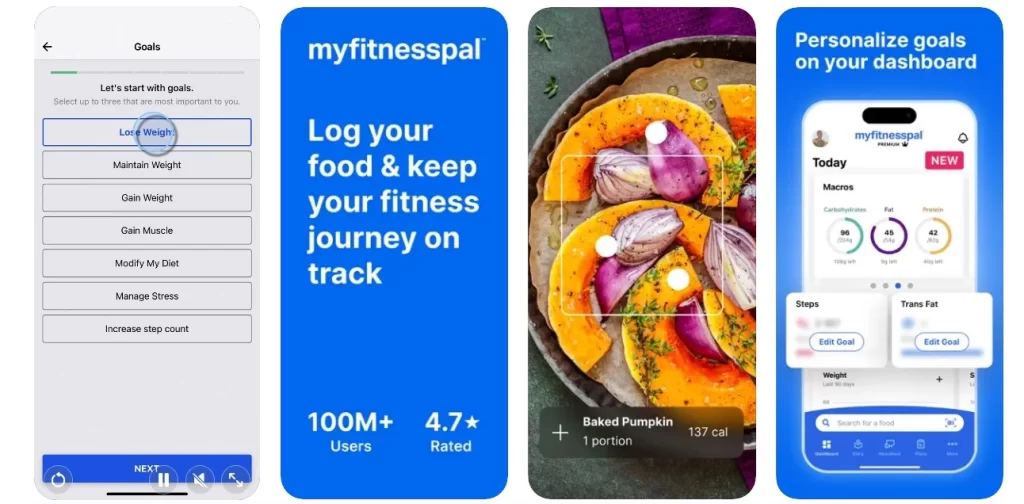
The Calorie Counter + app, developed by Nutracheck, seamlessly integrates with the service’s online food diary system, providing users with an intuitive and efficient tool for tracking nutrition. The app’s user-friendly interface makes it easy to add items to your food diary with just a few taps, and the inclusion of images or logos for each food item simplifies the recognition process. For added convenience, users can opt to scan barcodes, bypassing the need for manual searches.
Beyond calorie tracking, the app extends its functionality to include exercise logging and even integrates with Strava for tracking walks. Users can set daily targets for water intake, fruit consumption, and vegetable intake, promoting a holistic approach to wellness. While a free Lite membership is available, it comes with certain daily limits, and the app truly shines when upgraded to its premium subscription. Nutracheck also offers a free trial, allowing users to experience the full range of features before committing to the premium service.
| Founded Year | 2005 |
| Developed By | Nutracheck |
| Available On | Web, Android & iOS |
| App Downloads | 1M |
| App Ratings | 4.1 |
2. Lifesum
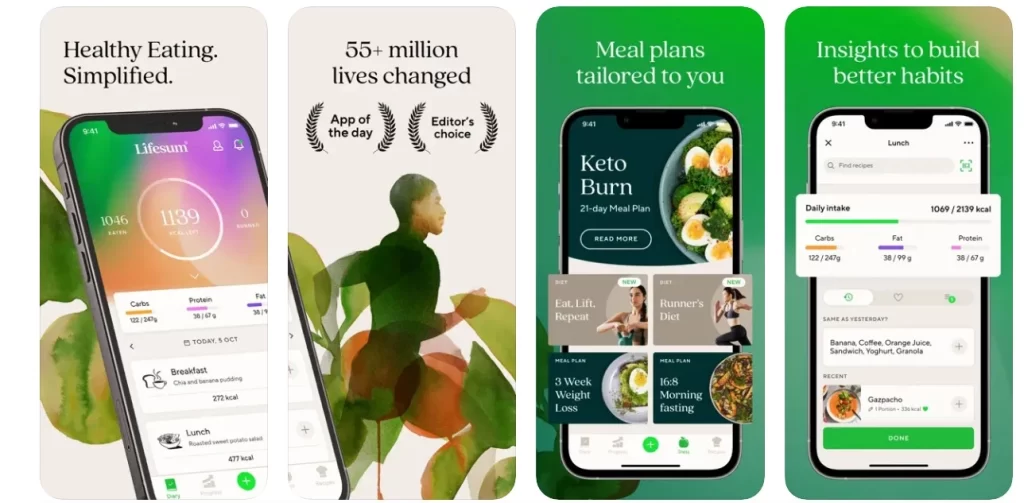
Lifesum offers a user-friendly experience for creating a personalized profile, setting dietary goals, and initiating an effortless meal plan. With a diverse food database featuring millions of items and a built-in barcode scanner for seamless food diary updates, Lifesum prioritizes convenience. Its habit trackers are especially beneficial for those aiming to increase water intake or incorporate more fruits and vegetables into their diet.
While the basic version, inclusive of the barcode scanning feature, is free, access to all features requires a nominal monthly subscription fee. This makes Lifesum an attractive choice for individuals seeking a holistic digital wellness companion.
| Founded Year | 2013 |
| Developed By | Lifesum |
| Available On | Web, Android & iOS |
| App Downloads | 10M |
| App Ratings | 4.1 |
3. Cronometer
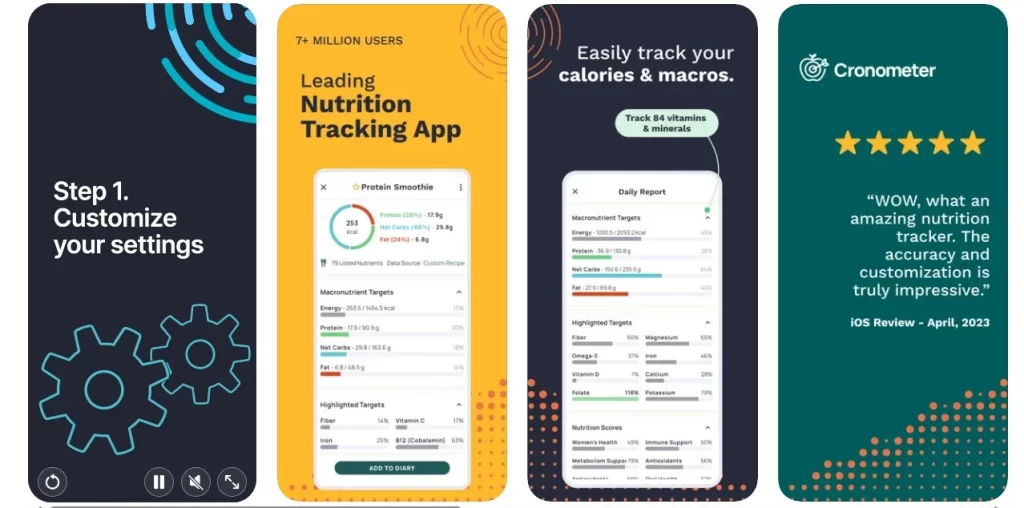
Cronometer stands out as a highly detailed food tracking app, distinguishing itself by allowing users to monitor up to 82 micronutrients. Even in its free version, the app surpasses many competitors in providing extensive nutritional information. The interface is modern and uncluttered, featuring a dark mode for enthusiasts.
Beyond food tracking, Cronometer supports various diets, incorporating a built-in fasting timer for intermittent fasting enthusiasts and a keto calculator for those following a ketogenic diet. The app includes a broad library of exercises, even estimating calorie expenditure for activities like driving or piloting a plane. While the free version is robust, premium features such as timestamps and the fasting timer are accessible through a paid Cronometer Gold subscription.
| Founded Year | 2011 |
| Developed By | Cronometer Software Inc. |
| Available On | Web, Android & iOS |
| App Downloads | 1M |
| App Ratings | 4.3 |
4. Lose It!
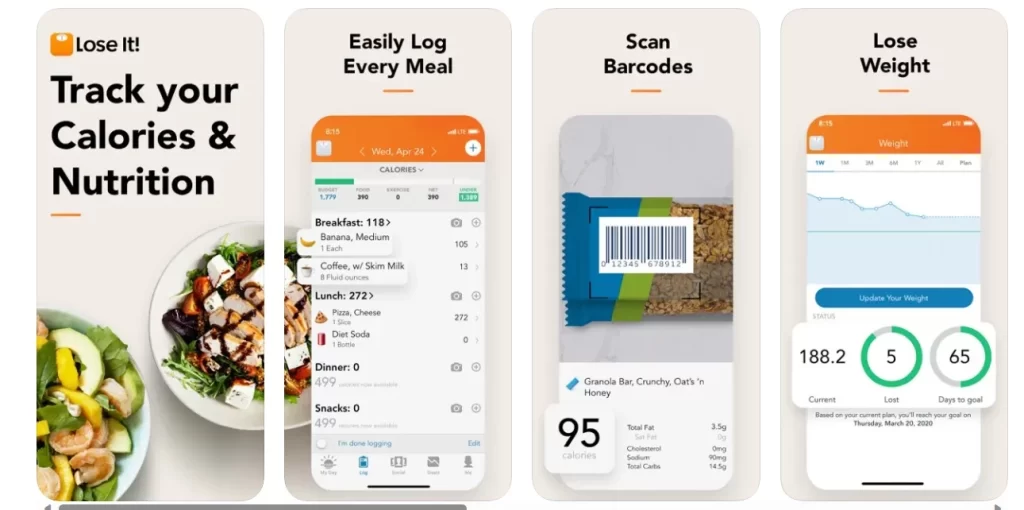
Dedicated to aiding weight loss, the Lose It! app boasts an extensive food tracking database with over 34 million items, ensuring convenient monitoring of daily intake. During profile setup, users respond to lifestyle questions, gauging past weight loss attempts and motivational factors. While initiating an account and basic diet tracking are free, additional features like personalized goals and habit tracking necessitate an upgrade. The app provides a comprehensive platform for users to embark on their weight loss journey, combining a vast food database with personalized goal-setting options.
| Founded Year | 2008 |
| Developed By | FitNow. |
| Available On | Web, Android & iOS |
| App Downloads | 10M |
| App Ratings | 4.1 |
5. Open Food Facts
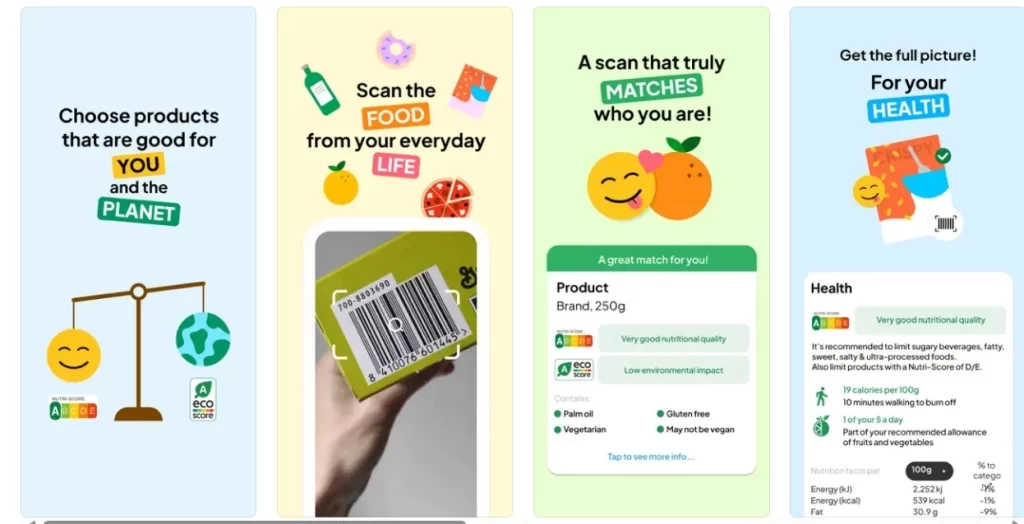
Open Food Facts, a non-profit app, serves as a valuable resource for users aiming to make informed dietary choices and decode food labels effortlessly. Whether through manual searches or barcode scans, users can access a product’s nutritional score, carbon footprint, ingredient list, and allergen information. The app facilitates the creation of lists to save preferred food items for later reference.
Notably, Open Food Facts stands out with its unique feature allowing users to set environmental food preferences, considering factors like forest footprint and overall eco score. Users can also customize settings to highlight allergens and specify food processing preferences. However, it falls short in catering to specific dietary needs, lacking the capability to filter foods based on diet types such as low FODMAP or keto-friendly, making it less suitable for those seeking such specialized information.
| Founded Year | 2012 |
| Developed By | Open Food Facts |
| Available On | Web, Android & iOS |
| App Downloads | 1M |
| App Ratings | 4.4 |
Tech Stack To Consider To Develop An App Like My FitnessPal
Developing an app like MyFitnessPal involves utilizing a combination of tools and technologies to ensure a seamless and feature-rich user experience. Here are tech stack that are commonly used in the development of fitness and nutrition apps:
1. Development Frameworks
- React Native
- Flutter
2. Backend Development
- Node.js
- Django
- Flask
3. Database Management
- Firebase
- MongoDB
- PostgreSQL
4. UI/UX Design
- Sketch
- Figma
- Adobe XD
5. Version Control
- Git
- GitHub
6. Cloud Services
- Amazon Web Services (AWS)
- Google Cloud Platform (GCP)
- Microsoft Azure
7. App Analytics
- Google Analytics
- Mixpanel
8. Payment Integration
- Stripe
- PayPal
- Braintree
9. Push Notifications
- Firebase Cloud Messaging (FCM)
- OneSignal
10. Testing Tools
- Appium
- Espresso
11. Collaboration and Communication
- Slack
- Microsoft Teams
12. Project Management
- Jira
- Trello
- Asana
Conclusion
In today’s health-conscious era, the popularity of calorie counters and fitness apps, encourage by the widespread use of app like MyFitnessPal.
This surge is indicative of a remarkable opportunity for entrepreneurs to join the fitness app wave and develop an innovative platform that resonates with users on their fitness journeys.
If you are an entrepreneur with a unique vision for an app similar to MyFitnessPal or seeking to redefine the fitness app landscape, you’ve come to the right place.
You can provide your company with a competitive edge by collaborating with our team and leveraging our fitness app development solutions.
Our app developers will collaborate with you to do a thorough analysis of your company and create a fitness app that is appropriate for it. Our team creates digital platforms using cutting-edge technology and best practices to ensure that they are secure, scalable, and user-friendly.
Give us a call right now to learn more about how our app development services may help you launch and grow your company.
FAQ
Q. How much does it cost to make an app like MyFitnessPal?
A. A number of variables, including the developer’s location, the application’s size and complexity, its UI/UX components, back-end development, the app testing procedure, the application’s deployment, post-deployment services, marketing, and promotions, affect the development cost of an app like My Fitness Pal.
Q. How do I make a fitness app like MyFitnessPal?
A. An app like MyFitnessPal can be developed by following the steps such as market analysis, verifying the app concept, determining the aim for the audience, choosing the model of monetization, selecting the essential features, design of UI/UX, selecting tech stack, employing fitness app developers for testing and deployment process.
Q. What features does the fitness app need?
A. There are several essential features to have in a fitness apps, such as Simple Onboarding, Push Notifications, Setting Objectives, Monitoring Progress, Dashboard.










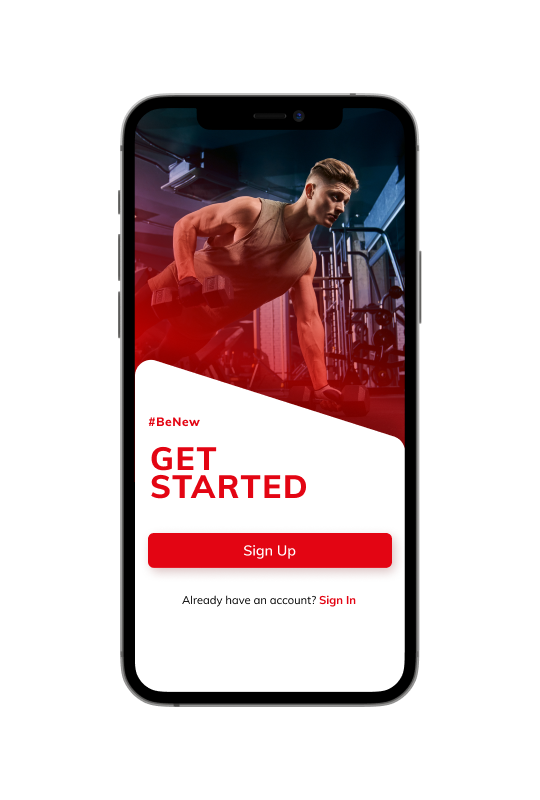


Gaurav Patil